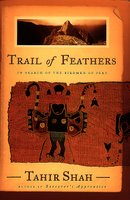TRAIL OF FEATHERS

When the Spanish Conquistador Francisco Pizzaro arrived in Peru, in 1532, his retinue of monks reported that the Incas 'flew like birds' over the jungles. Using primitive hang-gliders, they were said to be able to complete a fifteen-day journey across jungle in fifteen minutes. The Aztecs, too, supposedly made similar gliding contraptions from stork feathers, called 'crirs'.
Birds and flight are a central theme in all Amerindian and pre-Columbian lore. Ceremonial costumes in both North and South America were traditionally fashioned from feathers of falcons, condors and eagles. Hummingbirds, herons, and numerous birds of prey were actually worshipped by the Incas and their ancestors. The sacred Incan city of Machu Picchu was built in the shape of a bird with out-stretched wings, with its central shrine dedicated to the condor.
Given this obsession for flight, and the Spanish colonial documentation, is it so inconceivable that the Incas actually did manage to construct a very basic hang-glider, or flying canopy?
Working in the 1930s, the Polish Archaeologist Tenenbaum reported finding an engraving of an Aztec glider on a block of stone. He went so far as to declare that basic flight was known by many of the indigenous American peoples, and even suggested flying schools. Remarkably, few archaeologists since have given time or thought to the subject of primitive flight or, rather, to primitive gliding.
Despite this, there are dozens of mythological and cultural records which hint at the possibility. King Solomon's kingdom was said to have 'rasheds', simple gliders; as were the Maoris of New Zealand. An ancient Egyptian tomb, unearthed at Saqqara in 1898, was found to contain a model of a primitive glider, now housed in the Egyptian Museum, Cairo. And of course there was Icarus.
Since the 1920s archaeologists have been baffled by the colossal etchings on the plateau of Nazca, south-west of Lima. Many of the mysterious symbols are of exotic birds, which can only be appreciated from the air. Moreover, the mummified remains of the ancient Nazca people are routinely wrapped in exquisite textiles, many of which depict men with wings. Do the Nazca Lines and funereal textiles allude to an ancient flying fraternity? Or, are all the references to early American flight allegorical?
The answer may not lie in actual flight at all, but in an esoteric drink, called ayahuasca (which means 'Vine of the Dead'). The brew, which has been used by the tribes of the western Amazon for at least 10,000 years is a powerful hallucinogenic. Formed from the bark of Banisteriposis caapi, and a variety of other additives, ayahuasca is a favourite with Amerindian shamans, who use it today as the Incas did five centuries ago. For, ayahuasca gives all those who drink it the sensation of growing wings, and flying. Could the images of ancient Peruvian Bird-Men be those of participants in a cryptic ayahuasca ritual?
Trail of Feathers will be based on a journey through Peru, from Machu Picchu to Lake Titicaca, to the Nazca desert and on to Lima, before plunging into the tributaries of Amazon, in search of the clues into primitive flight. Did the Incas really fly in the world's first hang-gliders; or were their feathered gliders simply symbols in an hallucinogenic dream, inspired by ayahuasca?
Another area to examine is the very purpose of flight. For us, flying is a speedy way to get from A to B. For the Incas and their ancestors it seems as if flight was a way of getting closer to the gods… ritualist and ceremonial in purpose, rather than simply a method of transportation.
As well as scouring Peru's Incan and modern cities, and searching the western Amazonian region for clues, Tahir Shah will take part in ayahuasca ceremonies in the Peruvian Amazon ¾ searching for an answer into Incan flight of the fabled 'Bird-Men' of Peru.
Exactly a century after the Wright brothers' first glider flew at Kitty Hawk, Trail of Feathers will delve into the mystery of flight in more ancient times: a serious area which has almost exclusively been neglected by archaeologists and aviators.
0 Comments:
Post a Comment
<< Home